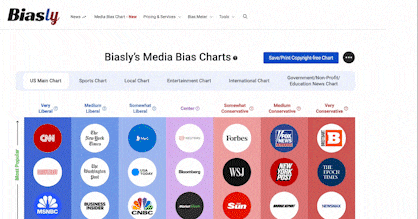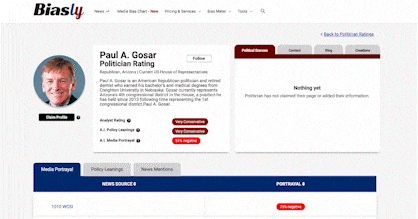 The Clarion-Ledger Article Rating
The Clarion-Ledger Article RatingMississippi relies on federal money. How could loan, grant pause affect the state?
- Bias Rating
-38% Somewhat Liberal
- Reliability
85% ReliableGood
- Policy Leaning
-32% Somewhat Liberal
- Politician Portrayal
-43% Negative
Continue For Free
Create your free account to see the in-depth bias analytics and more.
Continue
Continue
By creating an account, you agree to our Terms and Privacy Policy, and subscribe to email updates. Already a member: Log inBias Score Analysis
The A.I. bias rating includes policy and politician portrayal leanings based on the author’s tone found in the article using machine learning. Bias scores are on a scale of -100% to 100% with higher negative scores being more liberal and higher positive scores being more conservative, and 0% being neutral.
Sentiments
12% Positive
- Liberal
- Conservative
| Sentence | Sentiment | Bias |
|---|---|---|
Unlock this feature by upgrading to the Pro plan. | ||
Reliability Score Analysis
Policy Leaning Analysis
Politician Portrayal Analysis
Bias Meter
Extremely
Liberal
Very
Liberal
Moderately
Liberal
Somewhat Liberal
Center
Somewhat Conservative
Moderately
Conservative
Very
Conservative
Extremely
Conservative
-100%
Liberal
100%
Conservative

Contributing sentiments towards policy:
60% : Career and political appointees in the Executive Branch have a duty to align Federal spending and action with the will of the American people as expressed through Presidential priorities.58% : According to Reuters reporting, about 23% of Mississippi residents get Social Security payments for seniors and surviving dependents as of 2022.
56% : OMB covers many areas of public funding that could have consequences for the state like school lunches, road construction projects, research carried out in hospitals and universities, the Supplemental Nutrition Early Assistance Program and health care.
56% : Residents were ranked seventh-most dependent on federal support in the nation, and the state government was ranked ninth in the U.S.
56% : WalletHub noted that states that voted Republican in the 2020 election had a higher dependence on federal assistance than those that leaned Democrat.
55% : According Reuters reporting, about 65% of federal spending goes to benefit programs: Other federal spending goes toward defense (13%), interest payments (11%) and other spending (11%).
52% : For every $1 paid in income tax in Mississippi, the state takes in $2.53 in federal funding," according to a SmartAsset review of state budgets published in 2022.
52% : Programs affecting veterans being on the list include a housing rehabilitation and modification program, a suicide prevention grant and burial expenses.
47% : The project looked at factors such as return on taxes paid to the federal government and share of federal jobs to determine residents' dependency.
46% : Agencies under the executive branch include: According to Grants.gov, more than two dozen agencies make grants, including Education, Transportation and Defense.
45% : The Magnolia State pulled more than 47% of state revenues from federal sources.
43% : They are also directed to ID underperforming recipients and work to address problems, including cancelling awards.
41% : For example, Project 2025, a conservative playbook developed by the Heritage Foundation, calls for Medicaid funds to Planned Parenthood to be eliminated because the program provides abortions in addition to other health care for women.
40% : Trump initially distanced himself from Project 2025, but 31 of the 38 authors had ties to the president or his former administration, and he's chosen several authors for key roles in his new administration.
38% : A handful under DHS, includes: disaster grants for public assistance, hazard mitigation, community disaster loans and disaster unemployment assistance.
36% : Senate Appropriations Committee Vice Chair Patty Murray and House Appropriations Committee Ranking Member Rosa DeLauro wrote to Vaeth Monday night, saying the proposal would "only further disarray and inefficiency" following a string of executive orders from Trump.
*Our bias meter rating uses data science including sentiment analysis, machine learning and our proprietary algorithm for determining biases in news articles. Bias scores are on a scale of -100% to 100% with higher negative scores being more liberal and higher positive scores being more conservative, and 0% being neutral. The rating is an independent analysis and is not affiliated nor sponsored by the news source or any other organization.




























